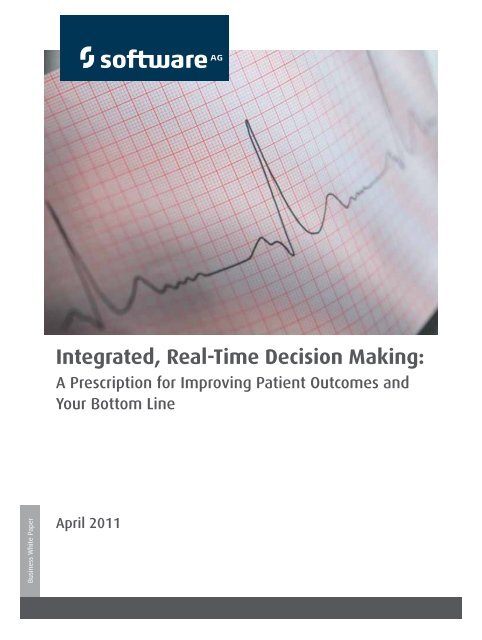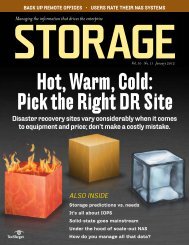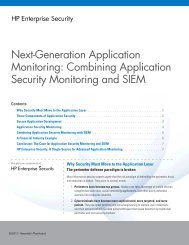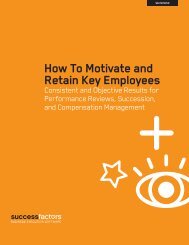Integrated, Real-Time Decision Making: - Bitpipe
Integrated, Real-Time Decision Making: - Bitpipe
Integrated, Real-Time Decision Making: - Bitpipe
You also want an ePaper? Increase the reach of your titles
YUMPU automatically turns print PDFs into web optimized ePapers that Google loves.
<strong>Integrated</strong>, <strong>Real</strong>-<strong>Time</strong> <strong>Decision</strong> <strong>Making</strong>:A Prescription for Improving Patient Outcomes andYour Bottom LineBusiness White PaperApril 2011
INTRODUCTIONAlmost universally, hospital executives state their mission this way: “Deliver the best possiblecare for patients while being fiscally responsible.” To achieve this goal they must resolve whatis sometimes seen as the tension between optimal patient care and costs. And when in doubtthey usually and understandably err on the side of patient care.As a result, many hospitals have succumbed to the “build it and they will come” syndrome. Inthe laudable desire to ensure that no detail is overlooked they proliferate systems andprocesses. But because these systems and processes have grown tactically rather thanstrategically they often remain unintegrated, highly specialized and inflexible. The inability ofthese disparate systems to consolidate and share data can lead to the very problems ofpatient care they are intended to prevent – and the ballooning of costs they should help tocontrol.Experience in numerous industries, including healthcare, has shown that integrated businessand data systems lead to greater effectiveness and greater efficiency. Such a proven set ofcapabilities forms the basis of the majority of financial transactions in the United States.According to a leading market research firm, more than half of leading process-centriccompanies and more than one-third of the top 25 process-centric healthcare companies usesuch capabilities to provide the end-to-end process visibility required to cost-effectively deliversuperior service.Experience in numerousindustries, including healthcare,has shown that integratedbusiness and data systems leadto greater effectiveness andgreater efficiency.To help you explore the potential of these capabilities for healthcare organizations, this whitepaper will:• Examine the reality of unintegrated processes and data in healthcare settings• Describe a set of proven tools for achieving integration• Offer real-world examples of healthcare organizations that are applying these tools toaffect patient outcomes and control costs• Identify proven approaches to six specific and highly critical challenges for healthcareorganizations• Suggest what you can do to begin achieving enterprise integration and real-timedecision-makingWHITE PAPER | <strong>Real</strong>-<strong>Time</strong> Integration3
TODAY’S REALITYHospitals today face a variety of demanding requirements and business imperatives. Theyneed to:• Acquire more patients and avoid losing patients.• Adhere to applicable federal, state and payor requirements without adding extra work toalready highly utilized staff. This is a moving target for healthcare institutions. For example,since 2005 the Centers for Medicare and Medicaid Services require reporting on 10metrics. In 2010 the number increased to 72 metrics. And, most recently, healthcareinstitutions must address the specifications around “Meaningful Use” tests and reporting toqualify for government funding.• Eliminate adverse events and reduce patient wait times. Today, adverse events are thefourth leading cause of death in the U.S.– mostly around administered drugs. Across the U.S.today, 50 percent of patients don’t get the proper care whether it be preventative, acuteor chronic. This might soon be a reportable metric that the industry will be judged on.• Attract best possible staff and increase patient referrals.Unfortunately, numerous obstacles hinder many institutions from fully realizing these goals.These obstacles include siloed systems with little or no integration among them, and complexIT infrastructures that are often hard-wired, proprietary, and outdated. These systems are theresult not only of sub-optimal technological approaches but also of political and economicforces. They result in unwieldy processes that alienate patients, contribute to adverse events,and lag behind evolving business requirements.The Burden of IntegrationWithout the proper informationat the proper time, caregiversmust make decisions based onexperience, not on information.There are many nodes of information in healthcare institutions: clinical systems, administrativesystems, PACS system, monitoring databases, diagnostic repositories, drug informationsystems, external systems, and more. However, due to the lack of integration the data inthese systems is not contextualized in a way that provides information that can be used bycaregivers. Often, the burden of integration falls on the individual caregiver at the point ofcare, or what we call ‘the patient-based moment of truth.’ Without the proper information atthe proper time, caregivers must make decisions based on experience, not on information.These decisions are not just mission-critical, but can also be matters of life and death.Process ComplexityConsider a typical business process within a healthcare institution, whether it’s patientadmittance from the time they come through the ER to the time they are moved into a room,or any of many other processes. Typically, these processes are quite complex, consisting ofmany steps that can occur sequentially or sometimes concurrently. A single business processcan actually span many departments, service lines, and political boundaries within aninstitution. These additional layers of complexity can make it difficult to ensure smoothhand-offs and efficient processing, and can hinder the ability to pinpoint the bottlenecks. Infact, when a well-known major consulting firm was hired to map the processes for NASA andhighlight problems the project took less than one year. The same consulting firm worked fortwo years on mapping the processes at a major healthcare provider and gave up.4WHITE PAPER | <strong>Real</strong>-<strong>Time</strong> Integration
THE PATH TO INTEGRATIONYou can cut through the complexity and achieve visibility of your processes and businesswithin your institution and across your external partners by moving to a much more flexible ITarchitecture. Unfortunately, today there are few interconnected systems, and those that areinterconnected typically use point-to-point interfaces that require pervasive modifications toaccommodate changes to business requirements, making it difficult to comply with evolvingmandates. Users must navigate through multiple functional systems to perform a single task.They may have 20 percent of data at their fingertips and then need to get the other 80percent from other systems. The individual systems don’t communicate easily across functional,political, or technical boundaries, which makes it difficult to share information or reusefunctionality.Service-Oriented ArchitectureOften the first step in moving from point-to-point data collection to an integrated enterprise isto integrate existing data, eventually evolving to the integration of business and clinicalfunctions. This is the path to Service-Oriented Architecture or SOA.SOA provides the flexible information architecture required to decouple business functionsfrom hardwired, monolithic legacy applications. Application components or “services” are welldefined using common interfaces; they utilize a contract to define how services will beinvoked, and they interact in a loosely coupled manner. In this environment, the terms “client”and “server” are purely situational. At one moment, an application could act as a client bycalling an external service, while moments later, it may act as a service-provider when calledby another application to perform a task. When properly implemented, SOA ends the buildingand maintenance of point-to-point integrations. Using SOA, you can generate new services ina flexible and agile way by combining existing logic and exposing it via reusable services.Often the first step in movingfrom point-to-point datacollection to an integratedenterprise is to integrateexisting data, eventuallyevolving to the integration ofbusiness and clinical functions.Once your core business functions have been exposed as services, they can be integratedacross organizational boundaries. These loosely coupled services provide you with the abilityto respond to changing requirements because of the layer of abstraction that SOA providesbetween the services and the underlying technology. Meanwhile, SOA governance toolsensure that services and other assets within the SOA continually meet established expectationsfor security, performance, quality, and reliability.WHITE PAPER | <strong>Real</strong>-<strong>Time</strong> Integration5
Supporting Process ImprovementAchieving enterprise integration is just the first step. You still need to address the issue ofmultiple systems and interfaces to perform a single business function. In other words, youneed a way to simplify execution of single tasks and enable integration across functional andtechnical boundaries.You have no choice but to deal with such business processes. However, you do have a choiceof how to improve and manage them. You can implement them through passive technologicalosmosis that leads to a patchwork of processes that are imperfectly pieced together with pointsolutions, manual labor, and expensive ERP systems. Or you can employ a reasoned, disciplined,and innovative approach that confers significant competitive advantages.Using Business ProcessManagement (BPM) software,you can combine system stepswith guided human interactionsto create well-coordinatedbusiness processes.That’s where Healthcare Process Automation comes into play. Using Business Process Management(BPM) software, you can combine system steps with guided human interactions tocreate well-coordinated business processes. Using BPM technology, business users can makechanges without programming and without affecting the underlying infrastructure. Thisflexibility enables you to respond to new business requirements faster, especially given thatyou can’t know exactly how those requirements will evolve.Meanwhile, Business Activity Monitoring (BAM) software can provide you with end-to-endvisibility of processes and gives you the ability to monitor them in real time. Visibility, in turn,drives change as your organization and users, now with a clear picture of a process, see waysto improve it.In addition to providing end-to-end visibility, BAM provides real-time notifications of delays orissues within a process. You can establish and measure clinical markers or key performanceindicators (KPIs) within and across the enterprise and be alerted as these markers are beingapproached, not after the fact.These capabilities provide invaluable decision-support within your institution as well as acrossyour network, delivering actionable, contextualized information when and where it is needed– without disrupting your day-to-day operations or requiring clinicians to change practicehabits. With interoperability and visibility thus enabled, you can make the kind of real-time,integrated decisions that help you achieve your financial goals and fulfill your mission.6WHITE PAPER | <strong>Real</strong>-<strong>Time</strong> Integration
REAL-WORLD SUCCESSESMany healthcare organizations are already applying these principles and tools to improve theirprocesses. For example, TELUS Health Solutions, Canada’s leading electronic healthcaresolutions provider, is using Software AG’s webMethods technology to create that nation’s mostcomprehensive Electronic Health Records (EHR) system.Of course, if asked about EHR, many institutions will say that they practice it already. Butaccording to an analysis by one of the industry’s major consulting groups, less than 3 percentof the approximately 5000 hospitals in the United States have a documentable, effective,pervasive EHR. In absolute terms, that’s only 150 hospitals. Even if the figure is ten times thatnumber, it comes to only 1500 hospitals, which suggests that the overwhelming majority ofinstitutions would do well to think carefully about whether they have a genuine EHR.Toward a Comprehensive Electronic Health RecordTELUS Health Solutions is helping lead the change in Canadian healthcare through innovativeand proven information communication technology. The company was ranked #1 in Branham’sTop 10 List of Healthcare IT Companies in Canada in 2007 and 2008 and was named 2008Health Company of the Year by the Information Technology Association of Canada. TELUShandles millions of healthcare transactions each year and manages more than 4 million drugcards, covering 8.5 million Canadians.Canada is investing billions of dollars to build an EHR system that will enable healthcareproviders, coast to coast, to electronically and securely access and update any Canadian’shealth record. By 2016, the plan is for every Canadian to have an e-health record, containing avariety of medical documents, from doctor’s notes and diagnostic images to prescriptions andtest results.TELUS is delivering a Health Information Access Layer (HIAL) solution that aligns with theCanada Health Infoway Blueprint and will enable every provider in the province of Newfoundlandand Labrador to access Drug Information System (DIS) data. The solution leveragesSoftware AG’s webMethods product suite for integration, Service-Oriented Architecture (SOA),governance, portals, Business Process Management (BPM), and Business Activity Monitoring(BAM).TELUS Health Solutions is usingSoftware AG’s webMethodstechnology to create thatnation’s most comprehensiveElectronic Health Records (EHR)system.Among the first such provincial DIS systems in Canada, it will:• Give healthcare providers immediate access to EHRs at the point of care• Enable updates of EHRs in real-time, 24/7, integrating data from many sources• Improve collaboration between providers for the best possible patient care• Facilitate new ways to share information, leading to better business processes to improvepatient care• Help healthcare providers work more efficiently, leading to lower costs and shorter waittimesWHITE PAPER | <strong>Real</strong>-<strong>Time</strong> Integration7
At the core of the HIAL is the TELUS Health Integration Platform, the foundation of many TELUSofferings, which is based on the webMethods Enterprise Service Bus (ESB). The HealthIntegration Platform brings together data from virtually any system, including care-providerregistries, domain-specific clinical data repositories, hospital-based clinical informationsystems, and pharmacy practice systems.To access the DIS data, healthcare providers can use a portal, such as the Care Provider PortalTELUS developed using webMethods technology. They can then update the EHR data in realtime, so that the next provider has the latest, most accurate patient record. Providers can alsoaccess the same data through their EMRs connected to the HIAL.Benefits of the system include:• Delivering complete patient data at the point of care• Saving lives by reducing errors and keeping providers informed• Reducing costs by automating processes and leveraging existing technologies• Meeting HL7v3 standards for electronic health information exchange• Providing the ability to easily scale to meet the increased demand for EHRsWorking Directly with Doctors and Healthcare ProfessionalsThe Children’s Hospital of Eastern Ontario (CHEO) is an academic pediatric hospital affiliatedwith the University of Ottawa, with a mandate for care, research and teaching. Over the pastthirty years, CHEO has established itself as a world-class academic health sciences centerproviding leading-edge treatment, diagnostic and laboratory services for children and youthaged 0 to 18 years.Using the webMethods suite,CHEO is now able to aggregateall (7-10 or more) alarms foreach patient and process themagainst clinical markers definedby the senior staff.Pediatric hospitals like CHEO face a unique challenge in critical care. As a noted child careexpert puts it, “the status of children under critical care changes at a much more rapid ratethan it does in adults.” Therefore, the many monitoring devices used for children havethresholds set to provide staff with alerts that must be addressed individually. Because eachalert requires a dispatch, the frequency of alarms dictates that, with a given nursing staff, onlya low fixed number of children can be cared for. However, if the staff could understand eachpatient’s total alarm picture from the multiple monitors, they could better understand whichcase needed urgent attention and which case was routine.Using the webMethods suite, CHEO is now able to aggregate all (7-10 or more) alarms foreach patient and process them against clinical markers defined by the senior staff. Staff andcaregivers can efficiently and effectively monitor more patients, provide better care, and helpensure better patient outcomes. The staff has now evolved from reacting to anticipating astrending markers are met or exceeded.8WHITE PAPER | <strong>Real</strong>-<strong>Time</strong> Integration
MEETING SPECIFIC CHALLENGESThe foregoing examples only begin to suggest the wide variety of specific challenges thatindividual organizations face and that enablement of integrated, real-time decision-makingcan help meet. Six of the most common challenges – and proven approaches to them – includethe following:Gaining greater visibility into the health of the institution: Using the webMethodsintegration platform and webMethods Optimize for Process to get real-time analytics, you canachieve a holistic view of clinical and business operations and thereby quickly identify what’sworking well and pinpoint process bottlenecks in order to drive process improvements.Addressing more intense competition: In today’s competitive environment, you need newways to differentiate your organization by serving patients as quickly as possible whiledelivering the best possible care. The solution: a real-time, 360-degree patient view. With thewebMethods integration platform, you can aggregate and gain a reconciled view of patientdata faster across departments and partners to make better and more consistent decisions.The result: reduced patient wait times, improved customer satisfaction and improved outcomes.With the webMethodsintegration platform, youcan aggregate and gain areconciled view of patient datafaster across departments andpartners to make better andmore consistent decisions.Achieving clinical excellence and physician and employee satisfaction: Clinical excellenceand caregiver and employee satisfaction are mutually reinforcing. Better outcomes meanmore fulfilling work; and more fulfilled employees, equipped with the tools to do their jobs,translate into better outcomes. End-to-end healthcare process automation can greatly help tocreate that virtuous circle. With the webMethods Business Process Management Suite, you canautomate and monitor end-to-end processes, establish performance goals, and measure KeyPerformance Indicators. You can write and change clinical and business process rules—withoutIT’s help. And you can easily measure, alert and report on key clinical markers, increasingefficiency by automating system steps and guiding human interactions to complete processes.Streamlining reporting compliance: Complying with governmental reporting regulations iscumbersome and time-consuming. But with the flexible reporting and business intelligenceprovided by webMethods Optimize for Process you create regulatory reports for local, stateand federal agencies—faster and with less staff impact. Specifically for “Meaningful Use” SAGgreatly facilitates implementing, testing and reporting on all three tiers:• Data Collection, sharing and reporting• Implementation of structured information and continuous process improvement• <strong>Decision</strong> support and surveillanceEnabling HIPAA Compliance: In the US, compliance with the Health Insurance Portability andAccountability Act (HIPAA) is driving business processes. New laws, changing consumerattitudes, and Federal incentives have all forced health organizations to adapt their existingsystems to this new reality.WHITE PAPER | <strong>Real</strong>-<strong>Time</strong> Integration9
A HIPAA solution which provides rapid and seamless integration of Providers, Payers, Routers,and Sponsors to support HIPAA 4010, 4010 A1, and 5010 standards is key to successfulhealthcare integration. Software AG’s webMethods HIPAA Link Module is built upon thetop-ranked webMethods integration technology, giving it a proven foundation for integratingsystems inside and outside the organization. With this solution – any existing IT investmentcan be part of a HIPAA transaction process. This includes any system such as healthcarespecific systems like Epic, Cerner, GE, McKesson, Siemens and legacy systems such as MUMPS.Moreover the HIPAA Link solution also validates HIPAA transactions against frequently updatedcode sets to help maintain compliance and interoperability.The solution is built to scale and processes documents segment-by-segment for improvedperformance. It generates detailed error reports in HTML or XML formats, and automaticallysends e-mail alerts for quick resolution. In addition, the solution maintains the integrity of alltrading partner transactions by providing automatic archival of transaction messages, ensuringnon-repudiation of content. In a nutshell, the Software AG solution allows sharing of informationend-to-end, providing the scalability and flexibility that can only be found in enterpriselevelintegration products.Integrating disparate systems: As we have noted, having critical patient information andbusiness data locked in disparate systems leads to cumbersome, costly, and time-consumingprocesses; and point-to-point integrations are brittle and costly to maintain. The solution, aswe have also seen, is enterprise integration. Software AG offers mature, fully integratedcapabilities for building a flexible healthcare information integration architecture – featuringproven software to dramatically reduce integration time and costs. You can greatly improveinformation sharing, develop new applications and processes faster, and meet all of yourinformation integration needs with a single platform. Most importantly, you can achieve theintegration of patient processes and business processes that enable you to deliver the bestpossible care while remaining fiscally responsible.Augmenting limited in-house resources: Although you want to rapidly achieve enterpriseintegration, you may find yourself hampered by a lack of in-house resources for designing anddeploying a solution. Software AG can help. The experts in our Global Consulting Servicespractice can work with you to plan, design and implement a tailored information integrationsolution. By leveraging our extensive experience with the technology, you accelerate time todeployment and achieve sustainable results for the long term.10WHITE PAPER | <strong>Real</strong>-<strong>Time</strong> Integration
WHERE TO BEGINTechnology is no obstacle. The technology for achieving enterprise integration and real-timedecision-making is proven, flexible, and available. The real barriers holding back mostinstitutions are inside: Performance metrics are based on internal politics and functional silos,instead of being designed to guide behavior toward better patient and business outcomes.<strong>Decision</strong>s are made on the micro level, without considering the macro level. And, perhapsmost importantly, IT and the business are misaligned.Software AG’s team of senior advisors has spent many years helping organizations of all kindsovercome those barriers to optimal performance. They have long experience in formulatingstrategies for businesses in multiple industries, including healthcare, that specifically focus onachieving efficiency and differentiation through the application of technology.Our approach is not to change systems but rather to overlay them with intelligence, enablingorganizations to leverage their existing IT investments while overcoming the limitations ofthose legacies. Our methodology is applicable to any service line. And our strategy is to workwith our customers to find the best area in which to begin improvement so that they canrealize value in weeks rather than months or years. We then move to the next area forimprovement, building on the momentum of success and harnessing the enthusiasm of allconstituencies for ways of working that benefit patients, caregivers, and the bottom line.We invite you to contact us for a conversation on ways to help increase the health of yourinstitution and make it the best choice for patients and staff.Our strategy is to work with ourcustomers to find the best areain which to begin improvementso that they can realize valuein weeks rather than monthsor years.To learn more, please contact us at fastresults@softwareag.com or call (703) 860-5050.WHITE PAPER | <strong>Real</strong>-<strong>Time</strong> Integration11
T O F I N D T H E S O F T W A R E A G O F F I C E N E A R E S T Y O U ,P L E A S E V I S I T W W W . S O F T W A R E A G . C O MTake the next step to get there – faster.ABOUT SOFTWARE AGSoftware AG is the global leader in Business ProcessExcellence. Our 40 years of innovation include theinvention of the first high-performance transactionaldatabase, Adabas; the first business process analysisplatform, ARIS; and the first B2B server and SOAbasedintegration platform, webMethods.We offer our customers end-to-end BusinessProcess Management (BPM) solutions delivering lowTotal-Cost-of-Ownership and high ease of use. Ourindustry-leading brands, ARIS, webMethods, Adabas,Natural, CentraSite and IDS Scheer Consulting,represent a unique portfolio encompassing: processstrategy, design, integration and control; SOA-basedintegration and data management; process-drivenSAP implementation; and strategic processconsulting and services.Software AG – Get There Faster© 2011 Software AG. All rights reserved. Software AG and all Software AG productsare either trademarks or registered trademarks of Software AG. Other product andcompany names mentioned herein may be the trademarks of their respectiveowners.SAG_Healthcare_WP_Apr11
















